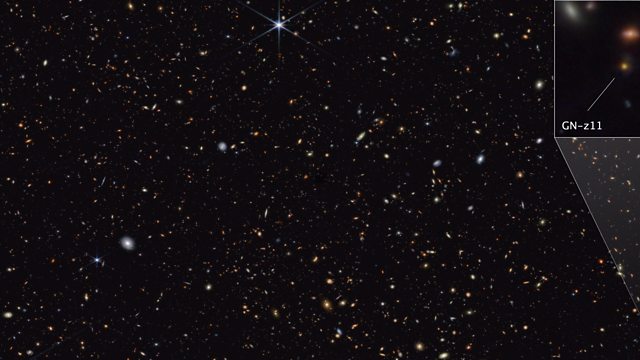The first stars in the universe
Astronomers using the James Webb Space Telescope think they have seen the glow from the first generation of stars after the Big Bang.
Astronomers using the James Webb Space Telescope think they have seen the glow from the first generation of stars after the Big Bang. Newton Kavli Fellow Hannah Γbler discusses.
The Anthropocene is meant to mean the latest geological era in which humanity is shaping the rocks and environment of our planet. But an unexpected vote by a commission has declined the idea of making this an official definition. Roland hears from one of its leading proponents, geologist Jan Zalasiewicz, about what happened and why it matters.
And, new research indicates that bumblebees can show each other how to solve puzzles too complex for them to learn on their own. Professor Lars Chittka put these clever insects to the test and found that they could learn through social interaction. How exactly did the experiment work, and what does this mean for our understanding of social insects? Reporter Hannah Fisher visits the bee lab at Queen Mary University in London.
Plus, the subterranean South American snake, or rather snake-like amphibian, that feeds its hatchlings milk from specially evolved glands. Brazilian biologist Carlos Jared explains more about this speciesβ nurturing behaviour.
Presenter: Roland Pease
Producer: Roland Pease
Production Coordinator: Jana Bennett-Holesworth
(Photo: A portion of the GOODS-North field of galaxies, highlighting the galaxy GN-z11, which is seen at a time just 430 million years after the Big Bang. Credit: Nasa/ESA/CSA/B. Robertson (UC Santa Cruz), B. Johnson (CfA), S. Tacchella (Cambridge), M. Rieke (University of Arizona), D. Eisenstein (CfA))
Last on
More episodes
Broadcasts
- Thu 7 Mar 2024 20:32GMTΒιΆΉΤΌΕΔ World Service Online, Americas and the Caribbean, UK DAB/Freeview & Europe and the Middle East only & ΒιΆΉΤΌΕΔ Afghan Radio
- Thu 7 Mar 2024 21:32GMTΒιΆΉΤΌΕΔ World Service except Online, Americas and the Caribbean, Europe and the Middle East & UK DAB/Freeview
- Fri 8 Mar 2024 05:32GMTΒιΆΉΤΌΕΔ World Service Australasia, Americas and the Caribbean, South Asia & East Asia only
- Fri 8 Mar 2024 09:32GMTΒιΆΉΤΌΕΔ World Service
- Fri 8 Mar 2024 13:32GMTΒιΆΉΤΌΕΔ World Service
Podcast
-
![]()
Science In Action
The ΒιΆΉΤΌΕΔ brings you all the week's science news.


